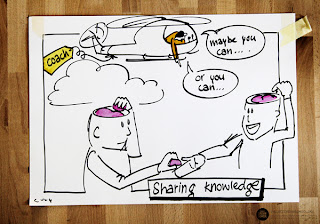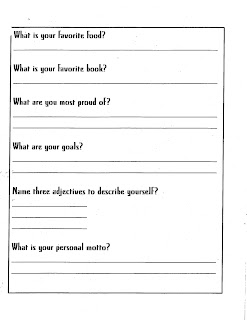A few weeks ago, I was asked to compile and share data on a student for our midyear review. This student is not in my homeroom class, and I thought about changing my mind at the last minute because I am not fully aware of the obstacles he has displayed in other school settings. However, I wanted to paint a picture of my interactions with him for one hour a day. I think that T.J. has reshaped my approach to teaching. He is a classic example of how if students are not learning the way we teach... we have to teach the way they learn...
Who is T.J.? When T.J. first walked into my room for reading groups on the first day of school, I saw a child who was unable to make eye contact and participate in reading discussions with other students. Later on that week, I learned that he had an obsession with Star Wars and fiddling with his hair that often distracted him from completing independent reading and word study assignments. I discovered that his home life and upbringing were not only different from all of the other students in the class, but quite a contrast from my family background. As the Diversity Resource Teacher at Woodbrook, I have tried to be more culturally responsive and reflective about how my students home life affects the way that I deliver instruction.
T.J.'s reading level coming into the second grade was a guided reading level F/G, and I thought that maybe, just maybe, he would be at a J at this point... He is instructional on both L and M level text. He exceeded his own expectations as well as mine. How did he do this? T.J. is a part of a viable and consistent co-teacher model where he receives biweekly reading conferences to follow up on his progress with specific reading strategy usage in his independent text. He also receives Title Support from the same reading teacher that co-teaches during his reading block. This consistency is a contributor in his academic and social progress. He is also able to see his fluency growth through a daily program called, "Read Naturally." This has proved to greatly increase his words per minute from 52 to 65 words per minute. T.J.'s spelling, word study, and handwriting are an ongoing obstacle. His co-teacher and I working to address this through word hunts and dictated sentences. Weekly meetings with my co-teacher have been very effective in supporting T.J.
In math, T.J. is on grade level and has a basic understanding of mathematical concepts but he needs reinforcements with explaining his thinking. I do not have him for my entire math block to address this, but I have had the opportunity to work with him during our grade level "Extended Learning Time." This instructional period is driven by exit slip data and midyear item analysis information. During this time, he has worked on creating strategy museums to display and explain his thinking while gaining stronger mastery. This particular instructional tool has helped to address our SIP goal which is for ALL students to unpack their thinking. For the students performing in the middle range, review is essential which takes place in the form of STMath, a revamped pacing aligned by investigations, and daily math routines.
So, who do I see when I see T.J. now? I see a student who holds his head a little higher and participates with less hesitation. Someone who started to be more focused when he moved up in our flexible reading group model.... Someone who proudly says on Fridays, "I finished my independent packet.... Did you see? I finished my work..." When I look at his published writing from "Being A Writer." I do see a lack of organization and questionable illustrations, but more importantly I see creativity and an outlet for expressing emotions. T.J. is a student who I had the opportunity to see win an engineering contest. It was obvious that his peers didn't see him as much competition, but he prevailed with flying colors. A father figure was not present, but his family was there supporting him in the only way they knew how to... a family that is "different but not deficient." T.J. is one of the many students who continuously teach me how to listen, observe, and respond without judgment. This is a skill that I am not always successful with, but I am trying to improve on with all of my students. So, next year when I have another T.J. walk into my room with similar issues, I won't put a ceiling on what they can accomplish. T.J. is a student who has gained some self-awareness, reading stamina, and managed to close his own reading gap. He's a student whose emotional maturity is not developed for reasons that I as a classroom teacher can't control. Some next steps for him could be receiving support from professionals in the building who have a higher level of expertise with social and emotional support.














































